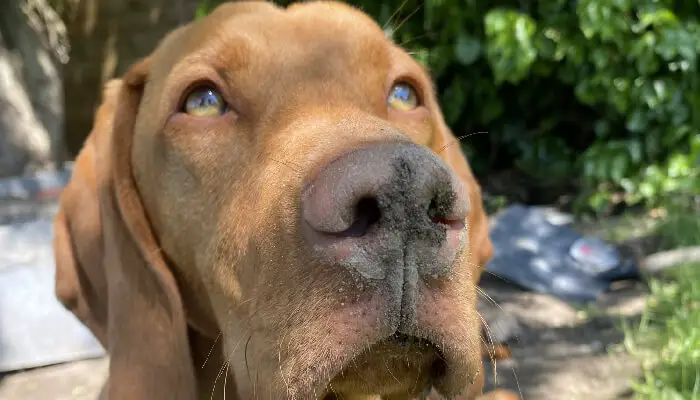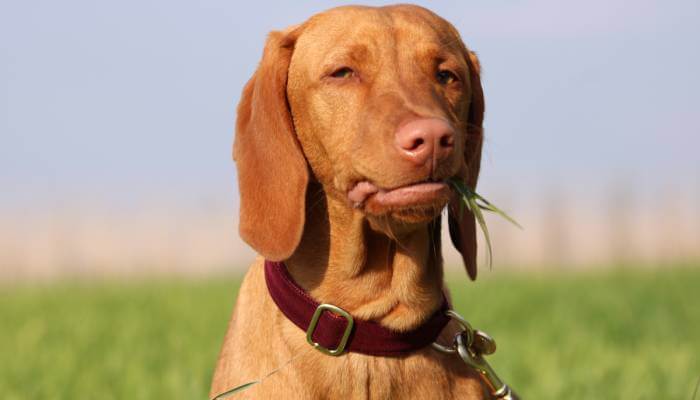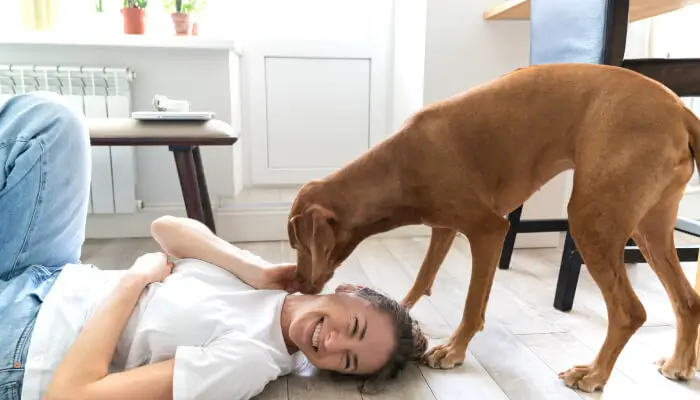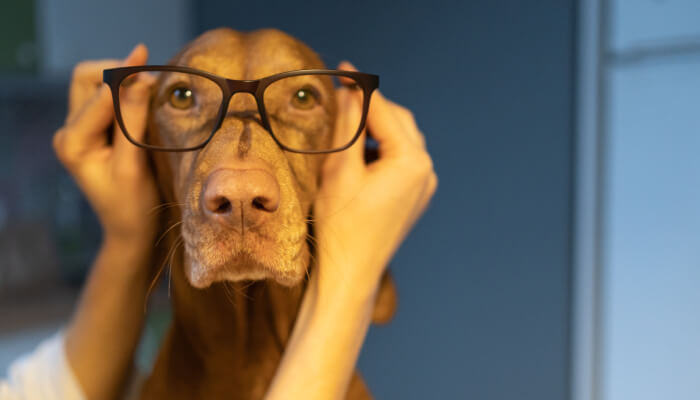Noses are one of the most sensitive parts of a Vizslas body. So why is my Vizsla’s nose turning brown? Why does my Vizsla’s nose look like it has rust on it? These are all questions that may be running through your mind right now, but don’t worry because I have answers for you.
Even though the brown nose of Vizsla isn’t unusual yet, many factors might be turning your Vizsla’nose brown. And they are dry air, winter, infection, allergies, injuries, age, exposure to the sun for a more extended period, dehydration, illness, and licking habit of your dog.
If your dog’s nose is changing its usual color, don’t worry because this article is for you. I will discuss all the reasons why your Vizsla’s nose might be turning brown in detail with tips to help stop the color change as you read further.
Why Is My Vizsla’s Nose Turning Brown?
Vizslas are perfect pets for families. But that’s why it is essential to be cautious! So, be sure not to neglect to check the nose, ears, and paws of your pet every time you bathe or brush them.
Since even the black and brown nose looks beautiful in your pet, some owners don’t worry about changing the nose’s color. However, this could be a sign that there’s something wrong with their health. Here are some of the reasons why your Vizlas nose might turn brown:
Infection
Your Vizsla’s nose is turning brown because it may have an infection. When a dog has an infection, their body can’t fight the bacteria on its own, and they usually need help from medication to get better. Watch your pet for symptoms such as: swelling around the eye, nasal discharge, and fever.
Vizsla’s Nose Might Be turning Brown Due To Injury.
If you notice your Vizsla’s nose is turning brown, it could be the result of an injury! If there are any signs of bleeding or bruising near their nose, take them to see a vet right away for treatment. You can also use ice packs on swollen areas and use cotton balls soaked in water, and gently wipe away any discharge.
Allergies
The nose is one of the most sensitive parts of a Vizslas body, so it’s not uncommon for your pet to have allergies. If you notice that your Vizsla’s nose turns brown on an ongoing basis or starts turning red as well, take them to see a Vet.
Vizsla’s Nose Might Be turning Brown Due To Dry Air.
If your Vizsla’s nose turns brown and you live in a dry climate, this could be the reason- Why does my Vizsla’s nose turn brown? Unfortunately, it might not go back to normal without assistance from outside sources like humidifiers or saline spray.
Vizsla’s Nose Turns Brown In Winter
Vizslas are famous for their brown noses. However, in winter, the color of their nose could turn to a reddish or even yellow hue. Why does this happen? The color change is due to increased circulation flowing through the skin and tissues near the surface of your dog’s body (you might see pink patches on his neck if he’s a Vizsla). Why does this happen? The color change is due to increased circulation flowing through the skin and tissues near the surface of your dog’s body (you might see pink patches on his neck if he’s a Vizsla).
If you’re wondering whether the nose will turn back brown again, it should eventually.
Vizsla’s Nose Might Be turning Brown Due To Its Licking Habit.
Vizsla is prone to licking, which may cause excessive dryness and hair loss. In addition, when they lick themselves, especially around the oral cavity and lips, some saliva or food residue will end up on their nose, which may cause this color change.
Furthermore, continuous licking will make your Vizsla’s nose dry and itchy. As a result, the original pinkish hue of Vizsla will fade. And you threaten them. The nose will end up brownish.
Aging And Exposure To The Sun
When aging, your dog’s nose will turn brown due to a reaction in skin cells called melanin. With regular exposure to UV rays (sunlight), this natural substance gradually deteriorates and turns color, usually turning black or greyish-brown on the tip of their noses and ears. Still, sometimes it can also happen to other parts of their body.
Your Vizsla’s Nose Might be Turning Brown Due To Dehydration
Vizslas are more prone to dehydration because the skin is thin. Although this seems like it should be an easy fix, this breed also has an extra-long nose that quickly absorbs sun rays, which can cause their color to change in temperature and exposure.
IIness And Disease
Health issues change the physiological appearance of Vizsla. Thus, they appear paler and have brownish color on the nose.
The owner can first see any injuries or wounds in their Vizsla’s nose, which could turn its skin brown due to blood accumulation. Moreover, several viruses and illnesses can make the dog susceptible to diseases like nasal mites, cancer, and parasites in their nasal passage, which often causes a brown nose.
Your Vizsla’s Nose Is Turning Brown. Is It Serious?
Vizsla’s nose turning brown has several reasons, such as trauma, cancer, or congenital conditions. But there is no need to worry. Your pet’s nose will return to its natural color with time and proper care.
If your dog shows any one of the following signs along with a brown nose, it is fatal. So be on alert and pay attention to:
- Crust formation
- Inflammation
- Hyperkeratosis
- Serous, mucopurulent, or hemorrhagic discharge
- Frequent sneezing
- Your dog does not allow you to touch its nose.
- Swelling of the nasal planum
- Nasal ulceration or perforation (tiny hole in your dog’s septum)
- Inability to smell
- Coughing, wheezing, difficulty breathing
Is It Normal For A Vizsla’s Nose To Change Color?
Yes, changing the color of Vizsla’s nose in different seasons is normal. It’s just a change of pigment in the skin.
A Vizsla’s nose will change color to indicate the dog’s mood. The dog may be excited, defensive, or annoyed by something going on around it. If a Vizsla changes its’ color from brown to red, this likely means that the dog is happy and satisfied with something happening in its life. When they are anxious, their nose will often turn blue, and if they are angry, it turns a light gray.
Some Vizslas noses may change color when the dog is not feeling well or has an allergy to something in its environment. These dogs usually have problems with food allergies that result from consuming different types of proteins. If your Vizsla’s nose is turning brown, then it may be due to an allergy.
Will Vizsla’s Nose Turn Reddish Again?
If the dog has a food allergy, they will need to cut out that allergen from their diet for the color of their nose to return over time. If you are experiencing this problem, you may need to take your dog to the Vet for a proper diagnosis.
There may be other factors, such as an infection or tumor, causing Why Is My Vizslas Nose, Turning red? If these conditions exist, they will need treatment before the color of their nose changes again.
Can You Fix A Vizsla’s Nose?
Yes, it is possible to fix a Vizslas nose. So, the best suggestion is to consult with the Vet and remove all allergens that can cause your pet to turn brown in their beaks. If you cannot identify what’s causing this allergic reaction, visit a veterinarian for an examination before serious health issues occur.
How To Turn My Vizsla’s Nose Color Back To Normal?
If you have a Vizslas with Why Is My Vizslas Nose Turning Brown? Then it’s essential to start by addressing the underlying issue that is causing this. If your dog has food allergies, bring in their current diet and see the ingredients present. Avoid allergenic foods during their initial elimination phase and then reintroduce them one by one.
To avoid this, you can consider adopting the following methods to turn your Vidizla’s nose back to normal:
Supervise Of Your Visla’s Brown Nose
If your Vizsla’s nose is brown, it is probably because of the weather. Nevertheless, you should always check on it and, if possible, make changes to prevent further discoloration.
When did it turn brown? If in the winter there isn’t anything you can do about that (it happens). However, if not, be sure to monitor carefully, and avoid anything that can turn it brown.
Removal Of Allergens That Might Cause Your Vizsla’s Nose To, Be Brown
Vizslas are typically prone to allergies, so pay close attention. However, discoloration may be sudden or excessive with itching and redness if it’s an allergy.
Vizslas are incapable of having allergies, but occasionally the nose may turn brown because they are allergic to something in their diet or environment. These allergens can cause the dog’s skin cells that produce oil (sebaceous glands) to release an abnormal amount of fat and result in a brown-colored nose.
Therefore, you should brush your dog/cat and bathe them. Also, remove all chemicals that could be causing the reaction on their skin (detergents, cleansers, perfumes).
Use Soothing Agents
You can even use some soothing agents to turn Vizsla’s nose color back to normal. You can find soothing agents at a local pharmacy, and these should contain the active ingredients benzocaine or phenylephrine. Rub a few drops of the agent onto your dog’s nose each day until it turns brown again. Do not apply this product to areas other than the nose.
Look For Other Symptoms
Your Vizsla’s brown nose will usually resolve after you eliminate the allergens, but if it remains even after removing these allergens, it indicates health issues. Look for other symptoms before you consult professionals or visit a vet because they can help pinpoint what is wrong. These symptoms may indicate serious diseases:
- Fever
- Dry eye
- Facial swelling
- Coughing, sneezing, or wheezing
- Pale gums and tongue
- Decreased appetite.
If you detect any of these symptoms, consult a veterinarian as soon as possible to prevent severe health conditions from developing. The Vet will be able to identify the cause of your Vizsla’s brown nose and make a diagnosis.
Consult With The Vet
All breeds of dogs have different requirements and needs, so speak with a vet before recommending any treatments. In addition, Vizsla owners should remove potential allergens that can cause their dogs to have brown noses. Sometimes, even if your Vizsla had a brown nose due to allergies in the past. Yet, you can’t be sure that it’s the same in the present. So, it is better to speak with the Vet when you’re still unsure about why your Vizslas nose has turned brown.
Vizslas have a double coat of hair: coarser outer hairs or guard hairs and softer downy fur on their face.
The unusual color variation is natural for Vizslas, but if your dog’s nose has started turning brown, consult with a vet to check for an underlying allergy or disease causing this reaction.
How To Prevent Vizsla’s Nose From Turning Brown?
If you notice a frequent change in the nose color of your Vizsla, you must take precautions to protect its nose in the future. First, you should make sure your dog is eating a high-quality, allergen-free diet. In addition to this, you should monitor your dog’s environment for any toxins or allergens that may be causing a brown nose. Finally, if you notice a sudden change in the color of their nose, then it is best to take them to the Vet as soon as possible.
Besides this, you can also exercise your dog. Exercise will keep Vizsla’s nose and skin healthy. Thus, this improves the condition of their coat as well, therefore preventing a brown nose for Vizslas.
Further, massaging your Vizsla with coconut oil, olive oil, or other oils that are high in omega fatty acids will also help keep your pet’s nose and skin healthy. Along with this, you can also use soothing agents like aloe vera, witch hazel, and chamomile.
Conclusion
In conclusion, it is normal for a Vizsla’s nose to change color. The most common cause of brown noses in this breed is allergies. However, other causes may include sunburn or skin diseases like rosy nose syndrome. Your Vet will be able to diagnose the problem and prescribe treatment if needed. To prevent your pet’s nose from turning brown again, you can try using sunscreen with an SPF rating between 15-30 on their face when they go outside, as well as applying it indoors during winter months.
I hope this article has helped you overcome your confusion and answered all your doubts about why your Vizsla’s nose is turning brown.



